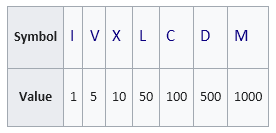Roman numerals are represented by seven different symbols: I, V, X, L, C, D and M.
Symbol Value
I 1
V 5
X 10
L 50
C 100
D 500
M 1000For example, 2 is written as II in Roman numeral, just two one's added together. 12 is written as XII, which is simply X + II. The number 27 is written as XXVII, which is XX + V + II.
Roman numerals are usually written largest to smallest from left to right. However, the numeral for four is not IIII. Instead, the number four is written as IV. Because the one is before the five we subtract it making four. The same principle applies to the number nine, which is written as IX. There are six instances where subtraction is used:
Ican be placed beforeV(5) andX(10) to make 4 and 9.Xcan be placed beforeL(50) andC(100) to make 40 and 90.Ccan be placed beforeD(500) andM(1000) to make 400 and 900.
Given a roman numeral, convert it to an integer.
Example 1:
Input: s = "III"
Output: 3
Explanation: III = 3.
Example 2:
Input: s = "LVIII"
Output: 58
Explanation: L = 50, V= 5, III = 3.
Example 3:
Input: s = "MCMXCIV"
Output: 1994
Explanation: M = 1000, CM = 900, XC = 90 and IV = 4.
Constraints:
1 <= s.length <= 15scontains only the characters('I', 'V', 'X', 'L', 'C', 'D', 'M').- It is guaranteed that
sis a valid roman numeral in the range[1, 3999].
- my solution
#include<iostream> using namespace std; int getValue(char ch) { if (ch == 'I') return 1; else if (ch == 'V') return 5; else if (ch == 'X') return 10; else if (ch == 'L') return 50; else if (ch == 'C') return 100; else if (ch == 'D') return 500; else if (ch == 'M') return 1000; } int romanToInt(string s) { int sum = 0; for (int i = 0; i < s.length(); i++) { if (getValue(s[i]) >= getValue(s[i + 1])) sum += getValue(s[i]); else sum -= getValue(s[i]); } return sum; } int main() { string s; cout << "Enter string: "; cin >> s; cout << "Result: " << romanToInt(s) << endl; return 0; }













No comments:
Post a Comment